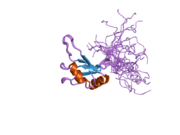DAZ associated protein 1
| DAZAP1 | |||||||||||||||||||||||||||||||||||||||||||||||||||
|---|---|---|---|---|---|---|---|---|---|---|---|---|---|---|---|---|---|---|---|---|---|---|---|---|---|---|---|---|---|---|---|---|---|---|---|---|---|---|---|---|---|---|---|---|---|---|---|---|---|---|---|
 | |||||||||||||||||||||||||||||||||||||||||||||||||||
| |||||||||||||||||||||||||||||||||||||||||||||||||||
| Identifiers | |||||||||||||||||||||||||||||||||||||||||||||||||||
| Aliases | DAZAP1, DAZ associated protein 1 | ||||||||||||||||||||||||||||||||||||||||||||||||||
| External IDs | OMIM: 607430; MGI: 1917498; HomoloGene: 137331; GeneCards: DAZAP1; OMA:DAZAP1 - orthologs | ||||||||||||||||||||||||||||||||||||||||||||||||||
| |||||||||||||||||||||||||||||||||||||||||||||||||||
| |||||||||||||||||||||||||||||||||||||||||||||||||||
| |||||||||||||||||||||||||||||||||||||||||||||||||||
| |||||||||||||||||||||||||||||||||||||||||||||||||||
| |||||||||||||||||||||||||||||||||||||||||||||||||||
| Wikidata | |||||||||||||||||||||||||||||||||||||||||||||||||||
| |||||||||||||||||||||||||||||||||||||||||||||||||||
DAZ-associated protein 1 is a protein that in humans is encoded by the DAZAP1 gene.[5][6]
Function
In mammals, the Y chromosome directs the development of the testes and plays an important role in spermatogenesis. A high percentage of infertile men have deletions that map to regions of the Y chromosome. The DAZ1 (Deleted in Azoospermia) gene cluster maps to the AZFc region of the Y chromosome and is deleted in many azoospermic and severely oligospermic men. It is thought that the DAZ gene cluster arose from the transposition, amplification, and pruning of the ancestral autosomal gene DAZL also involved in germ cell development and gametogenesis. This gene encodes an RNA-binding protein with two RNP motifs that was originally identified by its interaction with the infertility factors DAZ and DAZL. Two isoforms are encoded by transcript variants of this gene.[6]
Interactions
DAZ associated protein 1 has been shown to interact with DAZ1.[7]
References
- ^ a b c GRCh38: Ensembl release 89: ENSG00000071626 – Ensembl, May 2017
- ^ a b c GRCm38: Ensembl release 89: ENSMUSG00000069565 – Ensembl, May 2017
- ^ "Human PubMed Reference:". National Center for Biotechnology Information, U.S. National Library of Medicine.
- ^ "Mouse PubMed Reference:". National Center for Biotechnology Information, U.S. National Library of Medicine.
- ^ Tsui S, Dai T, Roettger S, Schempp W, Salido EC, Yen PH (August 2000). "Identification of two novel proteins that interact with germ-cell-specific RNA-binding proteins DAZ and DAZL1". Genomics. 65 (3): 266–73. doi:10.1006/geno.2000.6169. PMID 10857750.
- ^ a b "Entrez Gene: DAZAP1 DAZ associated protein 1".
- ^ Tsui S, Dai T, Roettger S, Schempp W, Salido EC, Yen PH (May 2000). "Identification of two novel proteins that interact with germ-cell-specific RNA-binding proteins DAZ and DAZL1". Genomics. 65 (3): 266–73. doi:10.1006/geno.2000.6169. PMID 10857750.
Further reading
- Dai T, Vera Y, Salido EC, Yen PH (2003). "Characterization of the mouse Dazap1 gene encoding an RNA-binding protein that interacts with infertility factors DAZ and DAZL". BMC Genomics. 2: 6. doi:10.1186/1471-2164-2-6. PMC 57980. PMID 11604102.
- Vera Y, Dai T, Hikim AP, Lue Y, Salido EC, Swerdloff RS, Yen PH (2003). "Deleted in azoospermia associated protein 1 shuttles between nucleus and cytoplasm during normal germ cell maturation". J. Androl. 23 (5): 622–8. doi:10.1002/j.1939-4640.2002.tb02303.x. PMID 12185095. S2CID 2486961.
- Prima V, Gore L, Caires A, Boomer T, Yoshinari M, Imaizumi M, Varella-Garcia M, Hunger SP (2005). "Cloning and functional characterization of MEF2D/DAZAP1 and DAZAP1/MEF2D fusion proteins created by a variant t(1;19)(q23;p13.3) in acute lymphoblastic leukemia". Leukemia. 19 (5): 806–13. doi:10.1038/sj.leu.2403684. PMID 15744350. S2CID 7228479.
- Pan HA, Lin YS, Lee KH, Huang JR, Lin YH, Kuo PL (2006). "Expression patterns of the DAZ-associated protein DAZAP1 in rat and human ovaries". Fertil. Steril. 84 (Suppl 2): 1089–94. doi:10.1016/j.fertnstert.2005.03.075. PMID 16209998.
- Morton S, Yang HT, Moleleki N, Campbell DG, Cohen P, Rousseau S (2006). "Phosphorylation of the ARE-binding protein DAZAP1 by ERK2 induces its dissociation from DAZ". Biochem. J. 399 (2): 265–73. doi:10.1042/BJ20060681. PMC 1609909. PMID 16848763.
- v
- t
- e
-
 2dgs: Solution structure of the second RNA binding domain in DAZ-associated protein 1
2dgs: Solution structure of the second RNA binding domain in DAZ-associated protein 1 -
 2dh8: Solution structure of the N-terminal RNA binding domain in DAZ-associated protein 1
2dh8: Solution structure of the N-terminal RNA binding domain in DAZ-associated protein 1
 | This article on a gene on human chromosome 19 is a stub. You can help Wikipedia by expanding it. |
- v
- t
- e





















